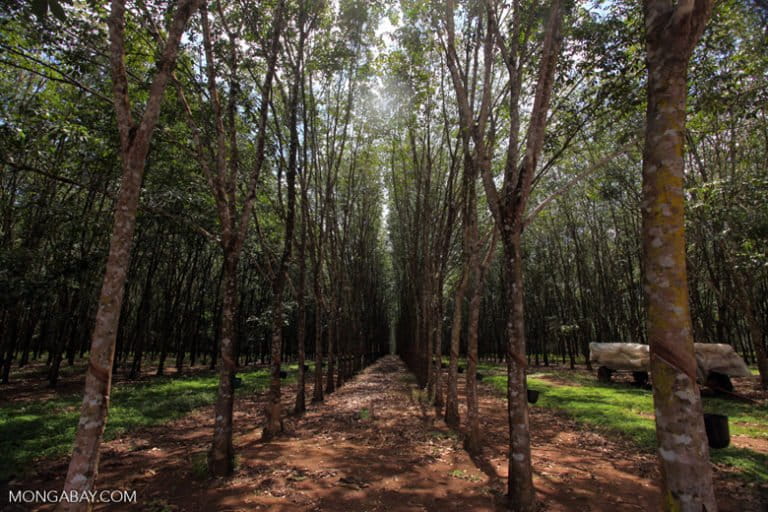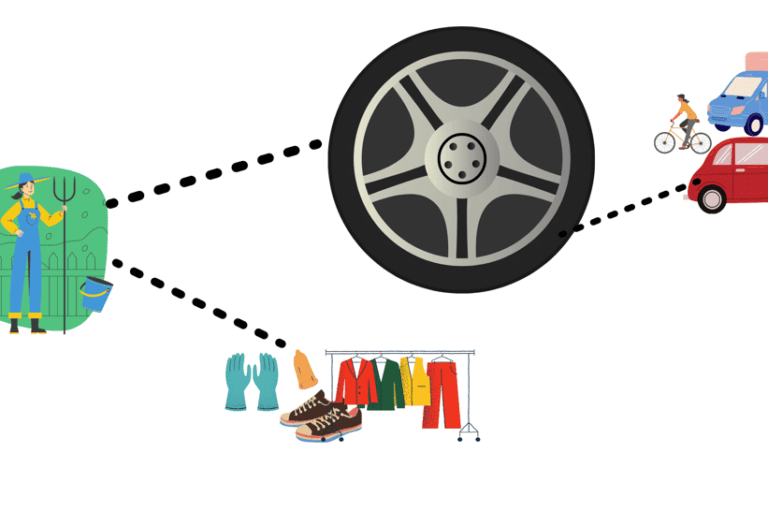- Six million smallholder farmers produce almost 90% of the world’s natural rubber: 70% of this goes to the tire industry, which then services other downstream users.
- Sold by the ton, there are some costs that are not included in the price especially when produced in an unsustainable way. These costs have historically included deforestation, forced labor, and corruption.
- The members of the relatively new Global Platform for Sustainable Natural Rubber aim to change that with a focus on sustainability in the rubber supply chain.
- This is a commentary. The views expressed are of the author, not necessarily Mongabay.
Every time I meet someone new and tell them I work on defining sustainability for the rubber industry, a range of questions follows. The most important of these typically is, “What’s stopping the industry from being sustainable right now?’’
I often fall back on metaphors to explain this, it’s how my brain works. However, today, almost two years into the inauguration of the Global Platform for Sustainable Natural Rubber, I’ve decided to be straightforward with you. This is mostly because no example or metaphor can come close enough to describing what a rollercoaster the last two years have been.
But first, here’s a little something about me. After working with the Roundtable for Sustainable Palm Oil (RSPO) for almost six years, I shifted gears to rubber. While the new challenges excited me, the most interesting part was the new opportunity; the opportunity to prevent the rubber of today from becoming the palm oil or plastic crisis of tomorrow.

Two years into the job, I can promise you that the opportunity still exists. In fact, I can see it more clearly than ever, especially as GPSNR grows from strength to strength. In a short span of time, almost 100 members from all across the rubber value chain have become part of the platform, and most are very actively engaged. Our most recent achievement is a policy framework that all members have committed to and are currently incorporating in their own policies.
This means GPSNR members are now committing to producing and sourcing natural rubber in a way that respects healthy functioning ecosystems and maintains protected areas and biodiversity. Commitments also include respect of customary and indigenous rights to land and forest resources and empowering workers with living wages, healthcare and education. Operationally, this will be achieved through sustainable plantation management and responsible rubber processing. From an economic perspective, the distribution of the value created will be equitable, creating resilient livelihoods and secure incomes. All this within an inclusive institutional infrastructure, giving all stakeholders access and an avenue for recourse in case of grievances.
What’s missing now, is a strong implementation process and a financial model to support it.
Defining the problem
Allow me to backtrack a little to give you some context. In the first few months of my time at GPSNR, I focussed solely on understanding the rubber value chain. I started to know of a supply chain where 6 million smallholder farmers produce almost 90% of the world’s natural rubber. 70% of the rubber they produce goes to the tire industry, which then services other downstream users.
In this universe, natural rubber is paid for by the ton, but there are some costs that are not included in the price point. These costs appear when we produce commodities in an unsustainable way. They include the cost of deforestation, forced labor and corruption, as few examples. Most times, these costs are borne by society as a whole and not just by producers and buyers. In economic terms, these costs which affect other parties without being reflected in market prices, as many of you already know, are called negative externalities.
Unfortunately, if we look at these negative externalities, we can quickly understand that there isn’t one villain or one force declaring war on the planet and insisting on unsustainable production.

The Solution
Because there is no one party that can take the entire blame, we must find a multiparty, systematic solution of how to internalize these negative externalities.
One of our struggles with sustainability is that those who are trying to do something good end up having to pay more for it: producers have to pay more to invest in sustainable production methods, and buyers have to pay more for products that have been assured or certified as sustainable.
On the other hand, those who are producing and/buying unsustainably seem to be paying less without any immediate concerns. Goods and materials that are produced in unsustainable ways become cheaper and more attractive alternatives (unless anyone complains). For example, a study by the American Forest & Paper Association estimated that illegal logging depresses world timber prices by between 7-16%, depending on the product. When timber that has been logged without proper payment of tax and duties pushes down the market price of timber, it acts as an incentive for other loggers to follow the same practices.
Because of this, simply incentivizing sustainability is not enough. Our model has to cover a plan that deters unsustainable production. The solution? A sustainability fee or surcharge on all the rubber produced.
In this way, no matter how it is produced, each ton of material contributes a small fee towards covering the cost of the externalities.
The dollars collected from this hypothetical fee or surcharge could be earmarked for a sustainability fund aimed at increasing supply chain resilience through training and disseminating knowledge of sustainable agricultural practices amongst farmers, or research to improve the productivity and sustainability of production. Should the rubber be assured to be sustainable, the fee could be removed.
This is not an original, out of the box idea, but I believe it fits perfectly in the rubber world because of one simple reason.
According to the diffusion of innovation model, for any innovation to reach mass market success, it must reach a tipping point – a critical mass of adopters.
See related: Global consumer demands fuel the extinction crisis facing the world’s primates

With GPSNR members making 50% of the world’s rubber volume, I believe we already have the ability to reach that tipping point to make this sustainability model successful in the rubber world. A sustainability tax or fee therefore, can become a non-negotiable in the industry.
In short, the opportunity for a sustainable natural rubber industry is shining through right in front of all of us.
I don’t purport to be a financial expert, so I must admit that the details of this idea have not been fleshed out completely. What form will this financial disincentive take? How will a company’s externalities be evaluated and assessed? What will the fee structure be like and who will develop, implement, and monitor it, and most importantly, how can we ensure this fee is not ultimately borne by the smallholders at the end of the supply chain? These are just a few of the questions that need to be answered. And of course, a good financial solution should account for the specific context and conditions under which they will be implemented, the groups and decision-making processes they target, and the policy and practical purpose they are intended to serve.

However, these questions are not what is stopping us right now. But then what is? I believe it is a simple yet significant human resistance to change.
For all the GPSNR members, partners and potential members who may be reading this, these conversations are not new. This paradigm shift is up to us, as an industry. Are we content with being casualties in this clash, picking up the pieces, each trying to do our part in silo? Or are we going to unite and turn the tables on those engaged in unsustainable practices by finding a way to hold them responsible for the damage they have done?
Our challenges are solvable, and our opportunities are greater than ever. We can wait till rubber becomes the new palm oil in the minds of consumers and be deemed responsible for a problem no one can solve as the world points fingers at us.
Or, we can internalize our negative externalities. We can account for them today, so that we do not have to throw more money at them tomorrow.
Stefano Savi is Platform Director of the Global Platform for Sustainable Natural Rubber.